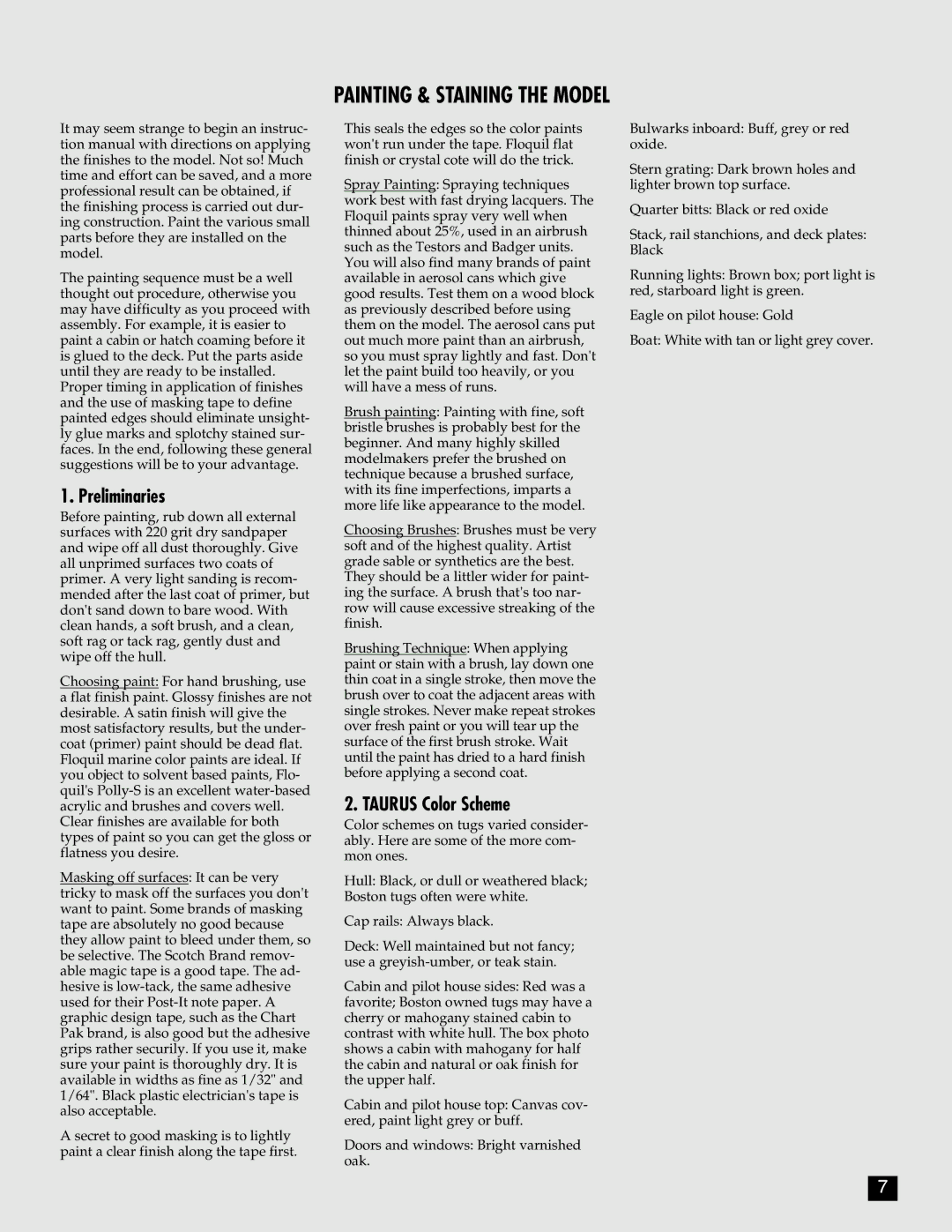
It may seem strange to begin an instruc- tion manual with directions on applying the finishes to the model. Not so! Much time and effort can be saved, and a more professional result can be obtained, if the finishing process is carried out dur- ing construction. Paint the various small parts before they are installed on the model.
The painting sequence must be a well thought out procedure, otherwise you may have difficulty as you proceed with assembly. For example, it is easier to paint a cabin or hatch coaming before it is glued to the deck. Put the parts aside until they are ready to be installed. Proper timing in application of finishes and the use of masking tape to define painted edges should eliminate unsight- ly glue marks and splotchy stained sur- faces. In the end, following these general suggestions will be to your advantage.
1. Preliminaries
Before painting, rub down all external surfaces with 220 grit dry sandpaper and wipe off all dust thoroughly. Give all unprimed surfaces two coats of primer. A very light sanding is recom- mended after the last coat of primer, but don't sand down to bare wood. With clean hands, a soft brush, and a clean, soft rag or tack rag, gently dust and wipe off the hull.
Choosing paint: For hand brushing, use a flat finish paint. Glossy finishes are not desirable. A satin finish will give the most satisfactory results, but the under- coat (primer) paint should be dead flat. Floquil marine color paints are ideal. If you object to solvent based paints, Flo- quil's
Masking off surfaces: It can be very tricky to mask off the surfaces you don't want to paint. Some brands of masking tape are absolutely no good because they allow paint to bleed under them, so be selective. The Scotch Brand remov- able magic tape is a good tape. The ad- hesive is
A secret to good masking is to lightly paint a clear finish along the tape first.
PAINTING & STAINING THE MODEL
This seals the edges so the color paints won't run under the tape. Floquil flat finish or crystal cote will do the trick.
Spray Painting: Spraying techniques work best with fast drying lacquers. The Floquil paints spray very well when thinned about 25%, used in an airbrush such as the Testors and Badger units. You will also find many brands of paint available in aerosol cans which give good results. Test them on a wood block as previously described before using them on the model. The aerosol cans put out much more paint than an airbrush, so you must spray lightly and fast. Don't let the paint build too heavily, or you will have a mess of runs.
Brush painting: Painting with fine, soft bristle brushes is probably best for the beginner. And many highly skilled modelmakers prefer the brushed on technique because a brushed surface, with its fine imperfections, imparts a more life like appearance to the model.
Choosing Brushes: Brushes must be very soft and of the highest quality. Artist grade sable or synthetics are the best. They should be a littler wider for paint- ing the surface. A brush that's too nar- row will cause excessive streaking of the finish.
Brushing Technique: When applying paint or stain with a brush, lay down one thin coat in a single stroke, then move the brush over to coat the adjacent areas with single strokes. Never make repeat strokes over fresh paint or you will tear up the surface of the first brush stroke. Wait until the paint has dried to a hard finish before applying a second coat.
2. TAURUS Color Scheme
Color schemes on tugs varied consider- ably. Here are some of the more com- mon ones.
Hull: Black, or dull or weathered black; Boston tugs often were white.
Cap rails: Always black.
Deck: Well maintained but not fancy; use a
Cabin and pilot house sides: Red was a favorite; Boston owned tugs may have a cherry or mahogany stained cabin to contrast with white hull. The box photo shows a cabin with mahogany for half the cabin and natural or oak finish for the upper half.
Cabin and pilot house top: Canvas cov- ered, paint light grey or buff.
Doors and windows: Bright varnished oak.
Bulwarks inboard: Buff, grey or red oxide.
Stern grating: Dark brown holes and lighter brown top surface.
Quarter bitts: Black or red oxide
Stack, rail stanchions, and deck plates: Black
Running lights: Brown box; port light is red, starboard light is green.
Eagle on pilot house: Gold
Boat: White with tan or light grey cover.
7
